Due to the features of the injection molding process, plastic products are easy to produce shrinkage, bubbles, fusion marks, trapped air, spray flow, and other appearance defects, which seriously affect the appearance quality of the product.
The causes of these defects include product structure design, mold design, raw material selection and quality, and injection process parameter settings.
This article aims to help product design engineers design plastic parts that meet product appearance requirements, from the product structure design and mold design aspects, while considering other factors that affect product appearance.
Selecting the suitable plastic tapes
Plastic material selection plays a vital role in the product’s appearance, and different plastic materials have various appearance performances. If you choose the wrong plastic material, even if you make corresponding adjustments in the product structure and mold structure, it is difficult to achieve the expected results and even impossible to solve the problem ever.
For example, the glass fiber-reinforced material is generally worse in appearance quality after injection molding than the non-glass fiber-reinforced material, and it is easy to warp.
Therefore, as a mold designer, it is necessary to master the characteristics of commonly used plastic types, evaluate the reasonableness of the plastic material chosen by the clients according to their demands for product appearance and function, and provide reasonable suggestions when necessary.
Avoid surface shrinkage of parts’ appearance.
Plastic parts are most likely to occur in the appearance of defects in surface shrinkage. Shrinkage generally occurs in the parts of the wall thickness of the outer surface of the corresponding parts, such as stiffeners, pillars, and wall connections, as shown in Figure 1.
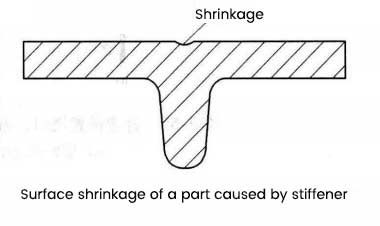
We can reduce and avoid surface shrinkage in the appearance of parts through a few methods
1 Masking shrinkage through design
We can use a U-shaped groove, slope, or ripple to cover the shrinkage, as shown in Figure 2.
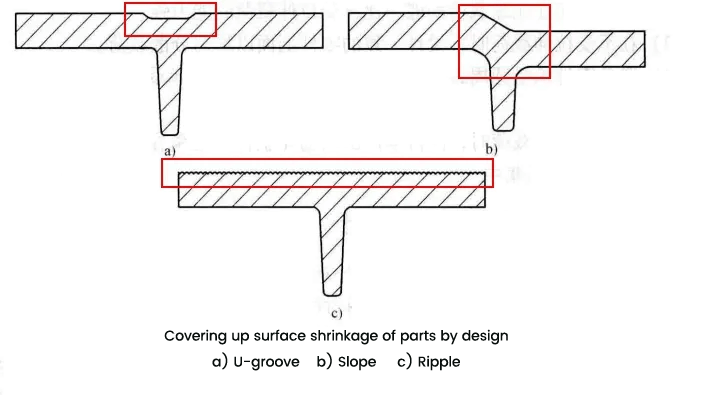
2 “Crater” design
Removing a little material from the root of the pillar or stiffener can significantly reduce the possibility of shrinkage in the appearance of the part, as shown in Figure 3. However, it is essential to note that this design can reduce the strength of the pillar or stiffener.
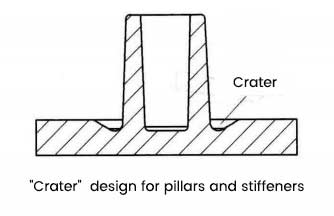
3 Reasonable gate location
The area of the part surface far from the injection molding gate is more likely to produce shrinkage. The area with high surface requirements should be as close to the gate as possible to reduce the possibility of shrinkage on the part’s surface.
At the same time, the location of the gate should make the plastic melt flow from the wall thickness to the thin wall, as shown in Figure 4. If the plastic melt flows from the thin wall to the thick wall, the thin wall will be cooled and solidified first, and the thick wall surface will easily produce shrinkage and air bubbles.
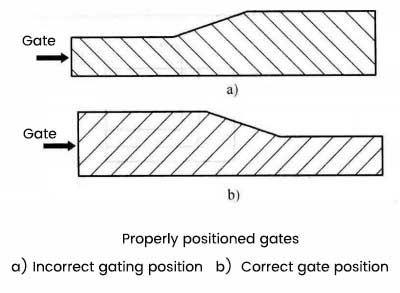
Predicting part deformation and reducing it through design
Part deformation not only causes poor accuracy but also causes poor assembly and functional fulfillment, as well as affects the appearance of the part.
The following four factors usually cause part deformation.
1 There are different shrinkage ratios between the plastic melt flow direction and the cross-sectional direction
Non glass-fiber-filled plastics
Shrinkage ratios in the melt flow direction are greater than in the cross-sectional direction, resulting in large shrinkage and distortion of the part.
Glass-fiber-filled plastics
The shrinkage rate in the flow direction is less than that in the cross-sectional direction, resulting in less shrinkage and deformation of the part.
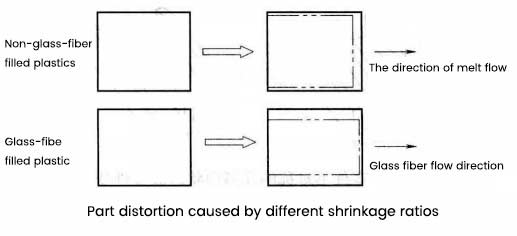
2 Uneven cooling of the part.
Uneven cooling of the part in the wall thickness direction can cause part distortion.
Uneven cooling may be caused by the uneven design of the injection mold cooling circuit.
It is also possible that the heat dissipation area on the outside of the part itself is larger than the heat dissipation area on the inside and that the heat dissipation rate on the inside and outside is inconsistent, resulting in product deformation. (See Figure 6).
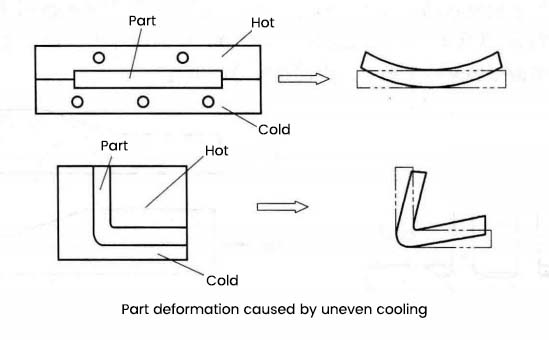
The direction of deformation of the part is always toward the hotter side of the part roll.
3 Deformation caused by the uneven wall thickness of the part.
The shrinkage of plastic parts increases with the wall thickness of the part, and the difference in shrinkage caused by uneven wall thickness is one of the main reasons for the deformation of thermoplastic parts. As shown in Figure 7.
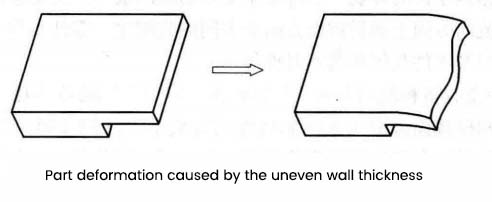
4 Asymmetrical part geometry causes part deformation.
The asymmetric geometry of the part can lead to uneven cooling and shrinkage differences, resulting in part deformation, as shown in Figure 8.
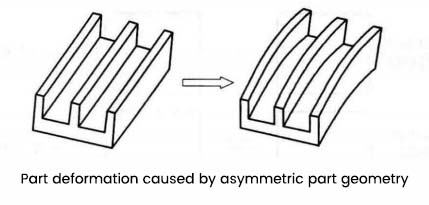
The four causes of part deformation we discussed above can be solved by some structural adjustments to affect the appearance of the part. As shown in Figure 9 and Figure 10.
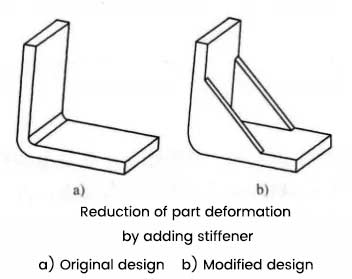
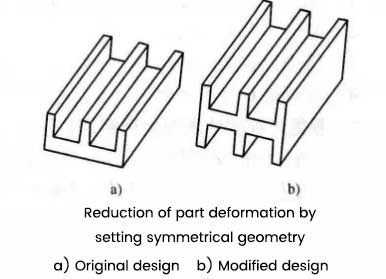
Beautify the gaps between parts
When two plastic parts are assembled, there will be a gap between the parts, affecting the product’s appearance.
The gap between the two plastic parts can be concealed by embellishing the design, thus improving the product’s appearance. Two kinds of beautification designs are commonly used, as shown in Figure 11-b and Figure 11-c.
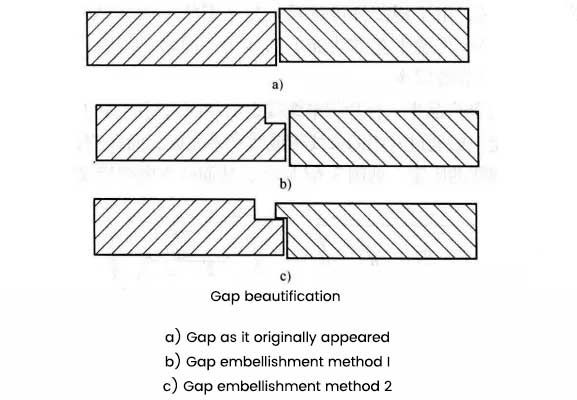
Of the two methods described above, the second method is better than the first.
The first design makes it possible for consumers to see the product’s internal parts because of the gap, and there is no dust-proof function.
Avoiding fusion marks on the surface of exterior parts
- The nibbling process can partially cover the surface of plastic parts, but this method does not entirely cover the fusion marks.
- Spray paint can cover the fusion marks.
- Set the location and number of gates reasonably to avoid fusion marks on the critical surface of the part.
- Make sure the venting inside the mold is smooth.
Rational selection of parting lines to avoid burrs on critical surfaces of parts
The intersection of convex and concave mold, core and core, core and convex and concave mold, etc., is very easy to appear flying edges. Therefore, product design engineers should carefully check the location of the parting line in the mold structure to avoid the appearance of flying edges on the critical surface of the part, which will affect the product’s appearance.
Do not place ejectors on the critical surface of the part.
Avoid placing ejector structures on the critical surface of the part, which can also produce flying edges. This is especially true for transparent plastic parts.
Summary
We have listed seven crucial factors and solutions that affect the appearance of products. In addition to these factors, other factors can affect the appearance too, especially the structural design of products, which is also the focus of our attention.
Accumulating experience and acquiring useful information can enable us to deal with various tasks with ease. We hope you can get enough information from our website and deal with various complex challenges together.
